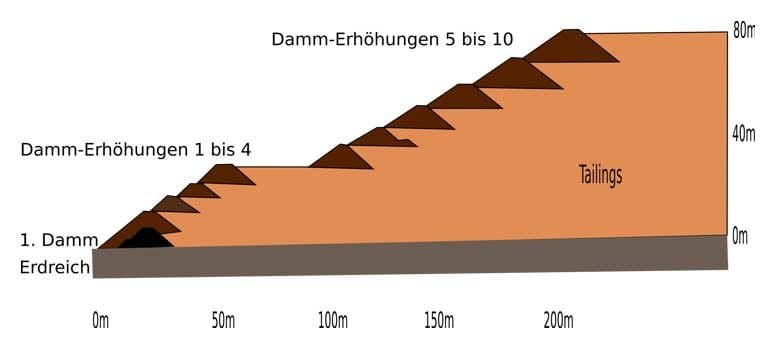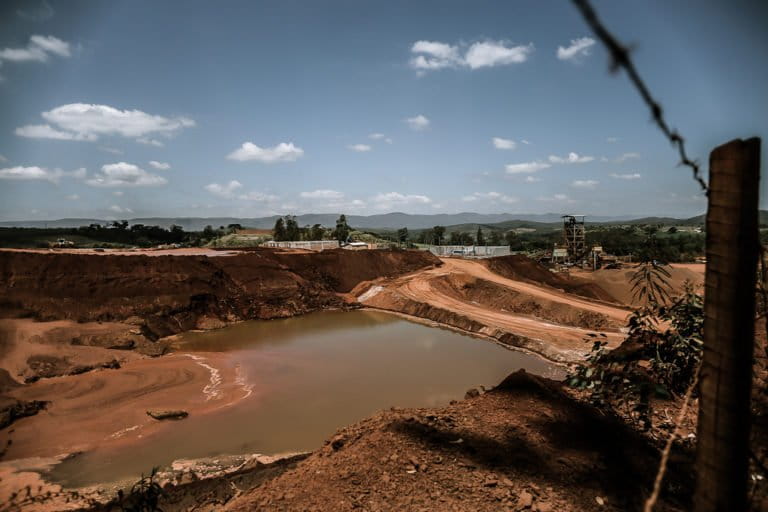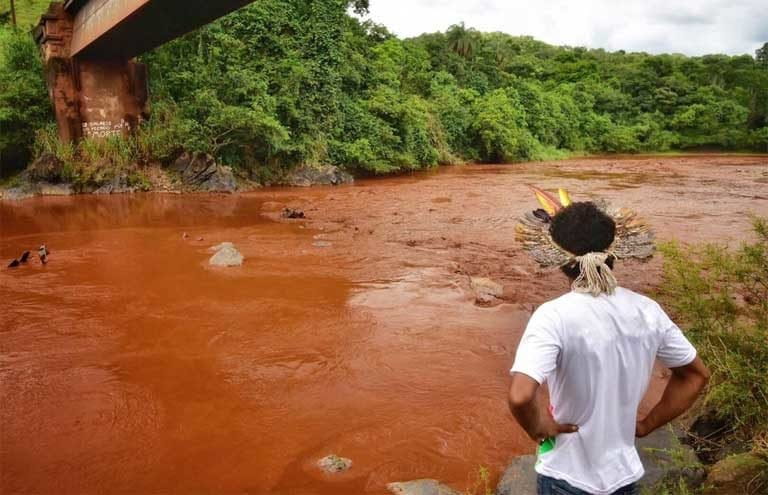- Even as Brazil’s newly seated Bolsonaro administration calls for the gutting of environmental licensing rules and for other environmental deregulation, a January collapse of a Vale Mining tailings storage dam in Brumadinho, killing more than 150 people with more than 180 missing and feared dead, has outraged Brazilians.
- The disaster is the second such accident in barely three years. In November 2015, another Vale-affiliated dam collapsed, also in Minas Gerais state, killing 19 and polluting the Doce River for 500 miles all the way to the Atlantic Ocean. The two accidents now vie for designation as Brazil’s worst environmental disaster.
- Mongabay’s investigation of the 2015 accident response and the national and state inspection system, while not all encompassing, shows a high degree of long-term failure by government, by mining companies, and inspection consultants to adequately assess tailings dam risk, and to repair structurally deficient dams.
- Three years after the Fundão dam failure, government and mining companies have received poor marks from critics for victim compensation and fixes for socio-environmental harm. On February 7th, Brazil said it aims to ban upstream tailings dams (UTDs), the type that failed both times. No details were released as to how Brazil’s 88 existing UTDs would be dismantled.

Marlene Iaquil Serra, 57, is one of the lucky ones. She escaped her home before the toxic sludge engulfed it. Her elderly mother, gone to visit a relative’s newborn, was spared as well, even as others died, inundated by a wave of rust-colored sludge and rocky debris.
These lucky escapes could describe events during the January 2019 Brumadinho Vale mining disaster.
But they don’t. Serra escaped from Bento Rodrigues on November 5, 2015 when the Fundão tailings dam, operated by Samarco and owned by two of the world’s largest mining companies, Vale and BHP Billiton, collapsed killing nineteen, including two children.
The 2015 Vale collapse dumped 50 million tons of iron mining waste into the Doce River, polluting it for 500 miles to the Atlantic Ocean, killing fish and other wildlife, and contaminating the drinking water for roughly 1.6 million Brazilians – including indigenous and traditional people who relied on the river for their livelihoods.
The disaster initially caused Vale’s share price to tank as Brazilians condemned the company and lax governmental oversight.
Three years later and Vale was again booming, but it is also presiding over a new flood of toxic mud. At lunchtime on January 25th, some 70 miles from Bento Rodrigues, the Feijão dam ruptured, spilling the same kind of iron mining waste, from the same sort of failed tailings dam that destroyed Bento, with far more deadly results.


This new catastrophe, unleashing 11.7 million cubic meters (413 million cubic feet) of mining waste, obliterated sections of the community of Brumadinho. As of 6 February, 150 bodies – along with unidentifiable body parts – had been recovered, while 182 people are still missing, feared dead.
“They need to think a little more about people, about human beings,” Serra said of Vale a few days after the latest catastrophe. “Those are lives. Vale makes a lot of money. Lives have no price. This has really affected people.”
Samarco, which operated the Fundão dam, has taken care of Serra and other Bento survivors since 2015. The firm pays her rent and provides a prepaid credit card to cover her family expenses. She is also waiting, patiently, for the new home the company promised to build; she says it is supposed to be ready next year – four years after the rupture.
The company told Mongabay it has spent 5.2 billion Reals (approximately US$1.4 billion) repairing damages and compensating victims since the Bento dam collapse through the Renova Foundation, created to handle these responsibilities. Renova said it has provided financial support to approximately 300,000 people.

When lightning strikes twice
The Brumadinho tragedy has Brazilians asking: “How could this have happened again?” The answer is partly historical; the region has depended on mining since the Portuguese arrived in Brazil. But responsibility also lies with the failures of successive governments – both left and right – to adequately regulate and hold corporations to account.
There’s another contributing cause: people need their mining jobs, so often just carry on when things go wrong. As of 2016, Minas Gerais, the state where both disasters happened, employed nearly 54,000 people in the mining industry, according to IBGE, the Brazilian Institute of Geography and Statistics.
In 2015, heavy industry – especially mining – accounted for more than R$4.6 billion (roughly US$ 1.2 billion) flowing in and out of the city of Mariana where the Bento Rodrigues disaster occurred. The service industry, by contrast, accounted for only a third that much. This outsized economic footprint helps explain the power and privilege that the mining industry enjoys in the state – in spite of repeated industrial disasters.
That overwhelming economic advantage may also explain why companies such as Vale take potentially terrible socio-environmental risks.
For example, according to one report, Samarco was attempting to quintuple the size of the Fundão waste reservoir by connecting two different tailing dams when the 2015 collapse happened. Experts say tailings dams are risky because instead of being built on solid ground, they use mine waste as their base and walls. These materials can shift or “liquify,” as an investigation by Vale and BHP Group Ltd. found happened at the Fundão dam. Video of the 2019 Brumadinho collapse show what appears to be a similar liquefaction process in horrific detail, with cars and people swept to their deaths by a failed dam and a deluge of toxic mud.

A 2017 United Nations Environmental Programme (UNEP) report, looking at tailings dams globally, found that “wet storage” of the type that destroyed both Bento Rodrigues and Brumadinho is responsible for most accidents and simply too dangerous to use. UNEP and its independent review panel, which including mining engineers, recommended a global shift to “dry stock storage” then, but mine operators have resisted because wet tailings disposal is cheaper than the dry storage method.
Although elected officials, NGOs and local activists pushed for stricter dam regulations after the 2015 disaster, the former Governor of Minas Gerais instead authorized a rapid approval process for industrial projects, including mines and dams. The B1 dam that failed in Brumadinho was part of a complex that Vale received approval to expand under this new fast-track system.

Brazil’s response to the 2015 disaster
The Brazilian government did take some steps to respond to the Fundão dam collapse. Samarco’s Fundão mine remains closed, and in 2016, the National Mining Production Department (DNPM) – now renamed the National Mining Agency (ANM) – suspended approval of mining concessions which planned to use new upstream tailings dams of the type that destroyed Bento Rodrigues.
However, that action only included dams that fit the National Dam Safety Policy specifications – meaning upstream tailings dams taller than 15 meters (49 feet) that hold more than 3 million cubic meters (more than 3.9 million cubic yards) of mining waste, with that waste considered to be dangerous or with dams having been found to have medium or high risks of fatal accidents in the event of collapse. The 2016 measure didn´t mention or regulate the dozens of existing upstream tailings dams across the nation, including the now collapsed B1 dam in Brumadinho.
As for human and social losses, if the country’s response to the 2015 Fundão dam collapse is any indication, then the residents of Brumadinho and those living along the now polluted Paraopeba River could end up waiting many years to see their damage claims resolved.
After the 2015 Fundão accident, instead of relying on the notoriously slow Brazilian judicial system to adjudicate compensation, the Renova Foundation, a private entity, was created as part of a judicial agreement (Terms of Transaction and Conduct Adjustment, TTAC), as a means to more quickly make reparations to impacted communities.However, “The Renova Foundation has proven to be a farce,” says Neto Barros, the mayor of Baixo Guandu, a city of 31,000 people on the Doce River heavily impacted by the toxic flood. The foundation “defends the interests of polluters,” Barros asserted.
He said that the registration system that Samarco set up to list affected people, establishing eligibility for financial compensation and support, grossly undercounts the number harmed. “There are fisherfolk, there are farmers, there are a lot of people who haven’t been helped. The pollution they created in our river is absurd,” said Barros.

Documented impacts include polluted drinking water drawn from the Doce River (clean ups have failed to make the water potable in many areas). A November report from Minas Gerais water agency, (IGAM), found that the stream still has high levels of metals such as manganese, aluminum and iron.
Early reports from local communities say that the Paraopeba River downstream of Brumadinho is similarly polluted. The Vale dam rupture has already destroyed at least 269 hectares (665 acres) of native Atlantic Forest, according to satellite data analyzed by Brazil’s IBAMA National Environmental Monitoring and Information Center.
Looking back at the 2015 Fundão dam failure, Samarco has paid exactly none of the 25 government fines, totaling 350.7 million Reals (US$95.8 million), assessed against it by IBAMA, the country’s environmental agency. “The company insists on appealing administrative decisions, seeking to remove its responsibility for the disaster. None of the environmental fines have been paid so far,” confirmed IBAMA’s press team.
The community of Baixo Guandu, to circumvent the long legal wait time and the low caps on potential compensation that apply in Brazil, has joined with 24 cities in a US$6.5 billion lawsuit filed in the United Kingdom against BHP Billiton, which co-owned the Fundão dam with Vale. Also signing onto this UK suit are 240,000 individuals, 11,000 businesses, 200 Krenak indigenous people, and a Catholic archdiocese.
Last November, just weeks before the newest dam disaster, the Renova Foundation reacted to the BHP Billiton court proceeding by offering 53 million Reals (around US$14.4 million) in compensation to Doce River municipalities, but only on the condition they withdraw from the UK lawsuit.

Criminal investigation stalled
Prosecution of those allegedly responsible in the Fundão dam collapse has also foundered. Brazilian prosecutors filed a criminal case against 22 people and four companies in 2016. The bulk of the witnesses for the prosecution testified in mid-2018. However, in October two defendants were granted habeas corpus rulings that removed them from the criminal proceeding. As a result, a judge cancelled the remaining scheduled hearings, halting the case.
Gustavo Oliveira, a Federal Public Ministry prosecutor in Minas Gerais, said that his office has filed a motion requesting the case move forward again. On the civil side, another prosecutor told Mongabay that in 2017 the companies agreed to pay for studies to determine the extent of the damage inflicted by the dam´s collapse.
A plodding pace isn’t the only challenge facing Fundão legal proceedings. In December 2016, a little over a year after the dam’s collapse, a new Minas Gerais attorney general transferred six prosecutors working on the case to other posts. These prosecutors were highly qualified with years of experience on technical environmental cases.

Likelihood of future tailings dam failures unknown
2016 data, gathered by states’ environmental agencies for Brazil’s Integrated Mining Dam Safety Management System, found that 147 mining dams rated with the highest risks of fatal accidents were located in Minas Gerais state. This total represents more than 65 percent of the highest risk category across all of Brazil.
Some of the highest-risk Minas Gerais dams are in populated areas, including the state capital Belo Horizonte and the town of Ouro Preto, a UNESCO World Heritage site known for its historic architecture. This raises serious safety concerns.
As of 2016, nine other states had 77 tailings dams with the same level of high risk for fatal accidents. According to the ANM,
Immediately following January’s Brumadinho disaster, the National Mining Agency (ANM) updated Brazil’s dam safety data. Unexpectedly, this new data doesn’t match up with the previous 2016 report
Only a single gold mine dam in the Rio Acima municipality of Minas Gerais is found on both the 2016 and 2019 reports. Some of these dams, listed as high risk just three years ago, are not even mentioned in the latest data.
“These dams may have been re-categorized, but I can’t assure you [of] their stability. We are still working on this data,” stated Eduardo Leão, a member of the ANM director board and Vale’s former Environment Director for the Carajás Project, the largest iron mine in the world, located in the Amazonian state of Pará.

Inadequate government inspections
Despite all of this uncertainty, the Brazilian government has concluded that mining impoundments in Minas Gerais and in other states pose a serious threat of collapse. In 2016, one year after the Samarco dam rupture, a Brazil Court of Auditors (TCU) presented the results of its investigation: “The country,” the TCU warned, “has latent and potential risks for new tailings-dams accidents.”
According to that report, the former federal government’s Mining Production Department (DNPM) inspection process was “fragile, faulty and did not achieve the goals of the National Dam Safety Policy.”
One of the more damning criticisms noted that while the department received and confirmed receipt of dam safety declarations about Brazil’s mining dams, it didn’t analyze the contents of those inspection reports. Dam safety inspections were also sporadic, done during rare onsite visits by DNPM inspectors.
“There may be dams in operation that are [defaulting on] the requirements of Dam Safety Plans and Emergency Action Plans, including dams that did not prepare the respective documents, since the DNPM does not evaluate these documents, or even [know] whether they exist, except through on-the-spot inspections, when and if they happen,” said the 2016 auditors’ report.

In 2012, for example, Samarco delayed sending information about the stability of the Fundão dam that eventually failed in Mariana. The company was only fined two years later, after irregularities were found.
The auditors’ investigation also revealed systemic issues within the agency that undermine its ability to perform its duties. “The flaws and irregularities uncovered during this audit involve the agency’s institutional operations,” says the report.
ANM’s Leão told Mongabay that: “Since 2016, our scenario hasn’t changed much: we still have budget issues and other challenges to conducting on-site monitoring. The report highlighted a number of shortcomings, and it’s not possible to fix the problems in such a short period of time.”

Accidents waiting to happen
One of the main critiques after the 2015 mining accident was that Samarco was allowed to monitor its own dam safety. The dam break in Brumadinho followed the same script: Vale was responsible for dam safety audits and for monitoring the stability of the Córrego do Feijão dam. This self-regulation process, however, was well within Brazilian law.
Brazil’s current National Dam Safety Policy was created in 2010, and it essentially allows the private sector to regulate itself. As a result, companies are responsible for the safety reports of more than 700 mining tailings dams in Brazil. Experts say this is a conflict of interest. In fact, two engineers from a German external auditing company hired by Vale, gave “declarations of the condition of stability” for the Brumadinho dam last year before its collapse. Both were arrested in connection with the disaster but have since been released. Similar concerns were raised regarding positive external safety audits preceding the Fundão disaster.
How does the government justify self-regulation and inspection by the mining industry? “The [mining] agency has been short of professionals for years, and we have reported that. There hasn’t been a civil service exam to hire new professionals since 2010, which results in responsibilities accumulating,” explained Paulo Ribeiro de Santana, a Mining National Agency geologist.
Santana serves as an example of the agency’s overburdened staff. The geologist handles both technical and communication functions within the agency. “We currently have 851 employees. Of these, just over 300 are about to retire. We work longer to avoid worsening the situation,” he reports.
“For all dams classified as high-risk – whether because of structural conditions or potential associated damage – we have determined responsive inspections with full-time video monitoring,” says Leão. “We have 740 mining tailings dams across the country and only 35 ANM inspectors. It’s impossible to monitor all of them: with this kind of [self-regulating] systems we could minimize these issues,” concludes the ANM director.

Policies primed for more tailings-dam disasters
A national trauma like the Samarco tailings-dam failure could have acted as a turning point for dam safety in Brazil. Instead, laws weren’t significantly toughened, and episodes with smaller socio-environmental impacts have occurred since then – including the 2018 leaks from the Hydro Alunorte aluminum processing waste dam in the Amazonian state of Pará, and two back-to-back Anglo-American iron mine slurry pipeline spills in Minas Gerais.
Within days of the Brumadinho disaster, the ANM responded by issuing a press release announcing that “businesses with high-risk dams must maintain full-time monitoring when the dams have upstream construction and people in their flood map area.” But with an implementation deadline of June 16, 2019, the order lacked urgency.
On February 7th, one of the directors of Brazil´s National Mining Agency (ANM) said it plans to ban upstream tailings dams. So far, no details have been released about how such a measure would be implemented, nor how the country´s 88 existing upstream tailings dams would be dismantled or converted.
IBAMA has issued 5 fines so far totaling $250 million Reals (nearly US$68.5 million) in the Brumadinho case. However, considering that none of the 2015 fines charged to Samarco have been paid, collecting such fines would require increased government enforcement and corporate compliance.

The newly inaugurated Bolsonaro government has taken some other steps since the new Vale dam rupture. On January 29, a presidential decree recommended a broad evaluation of tailings dam safety in all states. The day after, the Water Resource National Council (CNRH) also recommended that state agencies update their tailing dams data. New reports are expected in 3 months. These recommendations all carry less weight than a federal administrative order.
In recent years there have been legislative bills aimed at strengthening the agencies charged with monitoring tailings dams, such as the CNRH. But so far, mining interests have derailed these efforts, although the process by which the industry exercises its influence on government did shift between the administrations of Dilma Rousseff and Michel Temer.
“Because electoral campaigns could be financed with corporate money during the Dilma administration, mining companies were strengthened through the legislative branch. They influenced politicians formulating bills, such as the new Brazilian Mining Code,” explained Bruno Milanez, a researcher at the Federal University of Juiz de Fora, in Minas Gerais.
One example of industry influence includes a situation in which new mining code legislation was written on a computer belonging to a law firm that counts Vale Mining as a client. Deputy Leonardo Quintão, then responsible for shepherding the code through the legislative process, admitted that his run for Congress was funded by mining companies, Vale included.
According to Milanez, as soon as Michel Temer became president, the mining industry’s approach to controlling policymaking changed. A pro-corporate regulatory approach was guaranteed by appointing mining company executives to important positions in the National Mining Agency and the Ministry of Mines and Energy. Bolsonaro’s industry-friendly appointments have been similar.
Even a cursory study of the three years separating the Fundão and Brumadinho disasters suggests that – without the kind of ban now being proposed – more disasters could follow.
FEEDBACK: Use this form to send a message to the author of this post. If you want to post a public comment, you can do that at the bottom of the page.

